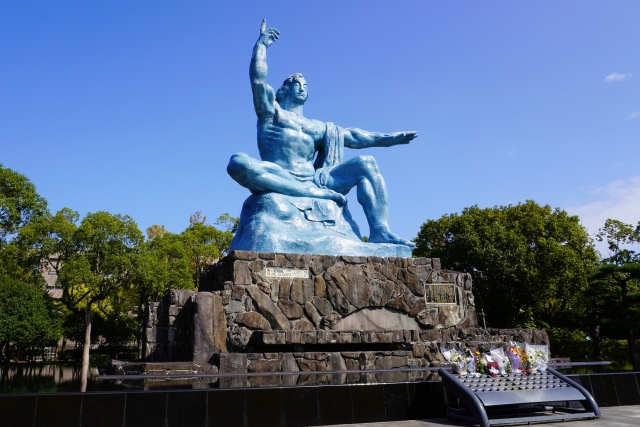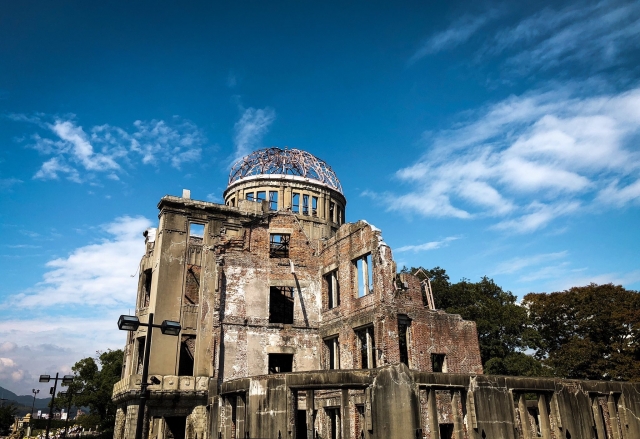About Peaceful Park
Built to commemorate the tragedy of the atomic bombing of Nagasaki in World War II, the park contains a tall statue of a prayer for peace and a memorial. The Nagasaki A-bombing Memorial Museum, located near the park, displays the ruined buildings and remnants of the atomic bombing as a warning to future generations and a prayer for world peace.

How to get there
From Nagasaki Station, take the train bound for “Akasama” and get off at “Matsuyamachi” stop, then walk for 3 minutes.
9 Matsuyama-cho, Nagasaki City
Tips
It is recommended to set aside 15 minutes of time is sufficient, the park is not large, a few statues sent by various countries in it.
Heiwa Park] expresses the wish of the Japanese people for world peace, and the famous sculpture “Peace Prayer Statue” was designed by the famous Japanese sculptor Kitamura Nishimitsu, and was built on the 10th anniversary of the August 8, 1955 bombing. The park is small, and the atmosphere inside the park is gloomy.
A small hill, not as affordable as the small store next to it to buy something.
The Japanese people are also victims of war, so they are also more yearning for peace
The free park, mainly to see that prayer statue and the atomic bomb monument, the monument is the location of the fall of the atomic bomb, of course, was exploded 500 meters in the air, next to the monument there was a dilapidated remains of that church at the time, this park is not large, near the atomic bomb history museum, the fee is also worth going.

Peaceful Park is a park established to pray for peace after the atomic bomb that was dropped on August 9, 1945 in the area between the center of the bomb and the hill to the north.
When you leave the parking lot, you will see a statue of peace and prayer made by Kitamura Nishimitsu, symbolizing the love of God and the compassion of Buddha. The raised right hand symbolizes the power of the A-bombing, the horizontally extended left hand means peace, and the lightly closed eyes are a prayer for the victims of the A-bombing.
At the north end of the park, there is a tower with a crane on each side of the statue.
In the center of the park is the crane-shaped fountain “Heiwa no Izumi”, and on the stone tablet in front of the fountain is a note from a young girl on the day of the A-bombing: “My throat was so dry, but there was a layer of black oil floating on the surface of the water, but I wanted to drink the water so badly that I finally drank it together with the black oil” (people who were exposed to radiation at the time died of dehydration and blackened bodies).
A little further on is “Nagasaki’s Clock”. This is where the death toll of 72,000 people was recorded, and many more were tortured by the after-effects of the radiation for the rest of their lives.
In fact, this was originally the site of the Urakami branch of the Nagasaki Penitentiary, where all the detainees and guards died on that day, and the ruins of several courtyard walls still remain.
There are 15 monuments in the park, including the German “Statue of Friendship among the Nations” and the Czech “Joy of Life”, which are mostly symbols of peace from the socialist countries of the time.
Of course, the most recognizable one is the “Flower of Life and Peace” of the Netherlands, whose national flower symbolizes all good things anyway.
China presented a “Maiden” statue
平和公园这个名字和英文又是对不上的,peace代表和平,这个是给世界人民看得,而平和应该是给中国人看得,看得出日本的野心,其实内心是不服输的,不服失败的。平和更多是一种心态,来到这里我就心感到日本文化对中国还是不同的态度的。
1945年的8月9日,长崎遭到美军原子弹的轰炸。市区三分之一被夷为平地,死伤人数达十余万。幸存下来的民众如今依然饱受癌症、白血病和皮肤灼伤等辐射后遗症的折磨。为了纪念此次灾难,1955年8月,长崎政府在原子弹核爆中心地带附近,建立和平公园。广场左边有核爆资料馆和一些小的纪念品店,公园里有一些世界各国赠送的雕像,显示了世界人民希望和平的心愿。
乘坐路面电车到松山町下,马路对面便是。
游客很少,但每个人到了这里都会感到一个凝固时空的肃穆。
公园内保留了一些炸后遗址,以及祈福所设立的塑像。
最有名的便是一手指天一手平举的人物塑像。很难想象眼前这份安宁多年前是怎样一番模样。
Website